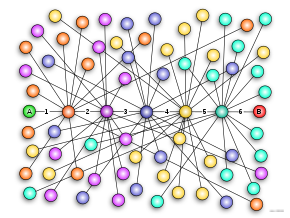The Small-World Experiment is a seminal study in social network[1] theory that aimed to understand the likelihood of two randomly selected individuals knowing each other. The experiment, which began in cities such as Omaha, Wichita, and Boston, sought to measure the average path lengths in a social network. Participants were asked to forward information packets, containing letters and business reply cards, to a known contact who was closer to the intended recipient. This technique was used to track the chain of connections and identify breaks in the chain. The results demonstrated varying chain lengths, with some links as short as one or two and others as long as nine or ten. The Small-World Experiment played a key role in shaping our understanding of social networks and has influenced several related concepts in social sciences and popular culture, like the Six Degrees of Kevin Bacon game and the Erdős number in mathematics.
This article needs additional citations for verification. (March 2008) |
The small-world experiment comprised several experiments conducted by Stanley Milgram and other researchers examining the average path length for social networks of people in the United States. The research was groundbreaking in that it suggested that human society is a small-world-type network characterized by short path-lengths. The experiments are often associated with the phrase "six degrees of separation", although Milgram did not use this term himself.
